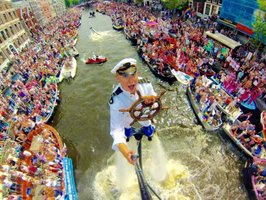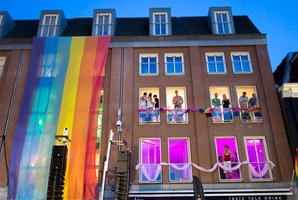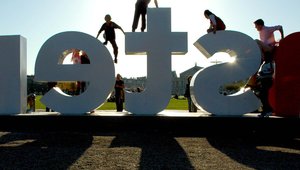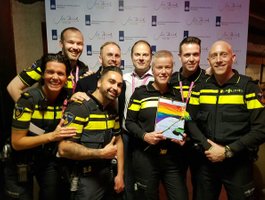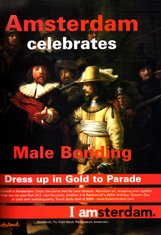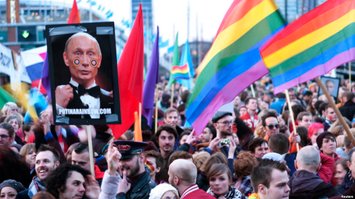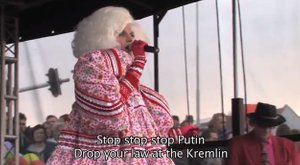Marketing the Rainbow
Click on pictures for larger image.
Introduction
The liberal attitude in the Netherlands, welcoming everyone in (almost) equal measure since the Middle Ages, made Amsterdam the ‘Gay Capital of Europe’, if not the world in the middle of last century. Herman ter Balkt of the Amsterdam Tourist & Conference Board (ATCB) observed as follows: “No city in Europe was so tolerant with regards to homosexuality. It was the only city where you could just enter a gay bar without having to ring a bell."
The last 10-15 years the tolerance - and acceptance! - in other European cities has grown rapidly. Cities like London, Paris, Cologne and Barcelona are all considerably larger than Amsterdam and meanwhile do not only offer their own inhabitants, but also LGBT tourists a large number of gay bars, clubs, events, film festivals, Pride, sauna’s, shops etc.
Yet, Amsterdam remains one of the most attractive cities for gay travellers in Europe. It offers the highest number of gay attractions per square meter. And because the city is so compact, all venues are within walking distance.
The first campaign (in the world?)
Up until the 1990’s the city’s public bodies (such as the tourist office VVV) promoted their destination as "free" and gay-friendly, the crown of which was the inauguration of the world's first Homomonument in 1987, to commemorate the LGBT victims of World War II. Experts emphasize the importance of the monument as a symbolic site of pilgrimage for many gay tourists, as a place of freedom, safety, peace and remembrance - also of those who died of AIDS.
But no real Marketing the Rainbow was involved until 1992, when the Netherlands Board of Tourism and Conventions (NBTC) was one of the first destination marketing organizations in the world to target the lesbian and gay market. Mulryan/Nash, a New York-based gay marketing and advertising agency, created a six-week print-ad campaign that ran in publications in 11 large U.S. cities. It was co-sponsored by Martinair and Eurodollar Rent-A-Car. The copy on one ad read: "Wide smiles. Sincere greetings. From people who respect your choices. And are especially glad you've chosen to visit them."
The 1992 campaign drew criticism from the city's 'mainstream tour operators', who feared for alienation of the straight tourists. A subsequent promotion in 1994 was called "Amsterdam, City On The Water", and no longer focused on the sexuality of the city. By the turn of the millennium, the cycle had turned once more, and gay male couples were used again to promote Amsterdam.
Due to a public debate about the image of Amsterdam abroad, the activities to promote the gay-friendly character of the city was shifted to private institutions, like the entrepreneurs. The abandonment of the theme, Amsterdam as a free city for lesbians and gay men, demonstrated that even in the supposed gay mecca of Amsterdam there are limits as to how far public bodies can go in supporting pink capital. It does still, however, form a stark contrast with the British policy that led to Clause 28.
Amsterdam Gay Capital, no more...
After years of undisputed rule, the Gay Capital label no longer seems to stick to Amsterdam. Having organized the extremely successful Gay Games in 1998 (not so much financially, as it was socially) - with a record number of participants - and after the introduction of same-sex marriage in 2001 as the first coungtry in the world, the subject more or less disappeared from the agenda.
Amsterdam Marketing is one of the sponsors of Gay Pride, but does not pay special attention to LGBT visitors. “We want to promote Amsterdam as creative capital and for that gays are important. But it is our goal to get more creative companies to settle in the city, not to make it a gay capital,” said director Charles van Renesse a few years ago. At present, the city is so overrun with tourists, that marketing efforts now focus on crowd control by spreading the visitors over the year, and over the city and region. Strangely enough, again no attention is paid to gay visitors, although they visit outisde the peak season, stay longer, and spend more per day...
Note: see my research for what makes a city “Gay Capital”, or in general “gay friendly” and the view of over 3,000 participants in my survey.
The downside
In recent years, the media reported some acts of aggression towards gays. Most notable was the case of the American journalist Chris Craine of the Washington Blade on Queen’s Day 2005, who was beaten up when he walked hand in hand with his boyfriend.
Unfortunately, the perpetrators almost always belong to specific muslim groups, for whom homosexuality still is a taboo. Luckily most local imams have realized that this attitude boomerangs back to the Islamic community and does not fit within the centuries of tolerant traditions in the city. A dialogue has started between Muslim leaders, the city and the LGBT community.
When a gay couple was severely assaulted in 2017 for holding hands, it prompted a challenge from (lesbian) journalist Barbara Barend, who called on men to hold hands in a show of solidarity, with the hashtag (in Dutch) #allmenholdhands. This quickly garnered wide support, so we saw the Vice PM, party leaders, the Dutch embassy men in London and the UN delegation in NY holding hands on the street. Football team NEC "turned their back on homophobia".
IAmsterdam
In 2004 the city hired prestigious advertising company KesselsKramer (KK) to build their reputation as desired destination for all. 'I amsterdam' began as the marketing campaign for the Amsterdam Area and its business and promotional organisations, but quickly took on a life of its own, becoming a collective catch phrase for the city's residents.
KK: "Most city campaigns draw attention to buildings, history, or other cultural highlights. The city of Amsterdam, however, wanted a different approach. ‘I Amsterdam’ was the result: a city identity campaign that celebrated Amsterdam’s citizens in all their diversity. The campaign included a gigantic three-dimensional version of the logo on the renowned Museumplein. Here, it’s become another Amsterdam monument, with visitors photographing themselves with, on, behind andin frotn of the letters. The slogan measures 2 by 23.5 metres and is situated near the Rijksmuseum. A second set of letters is at Schiphol Airport to welcome visitors to the city and a third set of letters playfully changes location around the city, making appearances at fashion shows, fairs, festivals and other major events. And finally, a scaled-down set of letters can also be found in the courtyard of the Amsterdam Museum.
Note: the creation of a word 'joined into' the city's name was not original, as LONDON had done so in 1998. And then there were Je suis Paris en Ich bin ein Berliner, of course.
The campaign only took off with a vengeance after the letters proved to be such a tourist magnet and social media success. The original "plywood" ones had to be reproduced into a more permanent display, multiple versions were made, including the traveling one, and tourists were encouraged to reinforce the hype that they themselves had started.
The city's website has a broad and up-to-date section with Upcoming gay & lesbian event highlights, including a 2 hour LGBT History Tour, which ends with a drink at Café ’t Mandje, Amsterdam’s (and perhaps the world's) first gay bar, which opened in 1927.
Official policy: "Amsterdam Gay Capital”
Early 2007, the council of the Center of Amsterdam released a policy document about “Amsterdam Gay Capital”, in order to make the city “tolerant, healthy, safe and vibrant” again. It was drawn up by a broad range of representatives from the LGBT community. The policy included 40 action points, such as:
- Studying the viability of a Homomuseum and finding a good location for it
- Care for seniors, handicapped and HIV-infected
- Health initiatives, such as STD-prevention and education
- Setting up a multifunctional LGBT center
- Give more room for innovating gay-related initiatives, events and festivities
- Give attention to ethnic minorities, both education and accommodation of LGBT
- Simplify permit system for big events and related activities, and gay horeca
- Expand on Gay Pride activities with flags, facilities and foreign outreach guests
- Appoint contact person for all LGBT related issues
- Ensure that the Tourist Board specifically addresses LGBT visitors
- Enhance gay areas, making them pedestrian zones in the evening, make them recognizable with flags and signs and safer with cameras
- Include Diversity in school programs
The commission of the city council advised positively on the Policy Proposal.
A subsequent 2008 initiative to create a Gay Walk of Fame has so far not materialized. In that year the ATCB, in cooperation with a local gay entrepreneur opened Gay Tourist Information Centre (GAYtic) and introduced a free personalized information kit.
In June 2009, the Amsterdam city council launched a three-year, 1.2 million Euro campaign to turn the tide. The campaign tackled the issue from two sides: a zero-tolerance policy towards hate crimes - in cooperation with police and the Ministry of Justice - was to address safety, but the campaign would also focus on social initiatives to improve the lives of homosexuals in Amsterdam.
No tolerance
Amsterdam shows no tolerance when aggression against gays is involved. The police corps has a special task force “Roze in Blauw” (Pink in Blue), which encourages gays to file a complaints in case they have encountered aggression because of their sexuality.
Symbolic for the moral support of the authorities is the participation in the annual Canal Parade of not only the mayors, but also some members of the cabinet, the police and the armed forces.
The incident with Mr. Crain – obviously – was widely reported in the US press, but it also had repercussions in Amsterdam. A survey held by the COC showed that a third of gays would no longer feel comfortable holdings hands in public in the city. Merijn Henfling, chief editor of gay youth magazine Expreszo, remarked that the incident could be deadly for the image of Amsterdam. ''In the USA they know about Theo van Gogh. Now this comes on top of it...'' Gay Business Amsterdam said the city, would loose ground to Barcelona and Parijs.
The mayor reacted that there were about 10-20 reported incidents of gay bashing a year, but exact numbers are not available because sexual preference is not always registered by the police.
Everyone's Gay in Amsterdam
After the new policy was drawn up, the Dutch tourist board launched a new advertising campaign in North America with the tagline "Everyone's Gay in Amsterdam". It featured posters of smiling people - and animals - and was designed to capture the 'all-inclusive and welcoming vibe' of the city, rather than focusing on gay stereotypes or sexualized images. In this context “gay” doesn’t just refer to sexual orientation, but “the attitude of the people in this grand European city,” according to VisualMerc, the New York-based interactive agency that created the website for the campaign.
The campaign appeared in Here Media’s Out and The Advocate magazines’ August 2009 issues. The multi-platform campaign with Here Media included digital content and custom webisodes highlighting Amsterdam on OutTraveler.com, a half-hour travel special on Here Networks featuring Amsterdam, and a series of events co-hosted by the NBTC and Here Media in New York, San Francisco and Los Angeles. The first was with a deluxe party at the Bogardus Mansion in New York City’s exclusive Tribeca neighborhood. The “Everyone’s Gay in Amsterdam” photo booth was the smash hit of the evening.
The campaign was co-sponsored by Air France-KLM and SkyTeam partner Delta airlines. It was nominated for the award of Outstanding Print Campaign by GLAAD.
A few years earlier, the famous Rijksmuseum was portrayed on a billboard poster that read "Amsterdam celebrates male bonding, Dress up in Gold to parade".
Somewhat later, light artist Daan Roosegaarde turned Central Station into a Rainbow Station. This looked very festive, but was not related to any LGBT activity (see below).
Pride Photo Award
In 2010, COC Amsterdam, IHLIA, Homomonument Foundation and Amsterdam's Baarsjes district council organized the first Pride Photo Award. The photo exhibition presented images that “reflect the true nature of Amsterdam Gay Capital: a city where each person can be himself or herself.“ It was meant to raise the profile of Amsterdam Gay Capital, internationally, nationally and locally. With this exhibition, the organizers wanted to overturn prejudice and stereotypes. Photographers were asked to send in their best photos that showcase "diversity of sexual orientation and identity".
As with World Press Photo, the best photos would be chosen in a number of categories. After the central exhibition, the winning photos were placed in the middle of a residential area (in fact, this turned out to be a predominantly Muslim area). The organizers wanted to stimulate discussion and increase the visibility of sexual diversity in the neighborhood and on the street. Subsequents exhibitions were in an old church in the red light disctrict. The award became an annual event, altough not in 2017 due to "drastic organizational changes and financial challenges".
Russian visit
The Netherlands is Russia's No. 1 trade partner in Europe, but that does not mean that we take everything for granted. In 2013 Amsterdam pulled out all the stops to "greet" Russian President Vladimir Putin. The Russian parliament had just passed a bill forbidding the dissemination of gay propaganda.
The canals were crowded with floats, and thousands of protesters came out waving vicious but creative signs. Even city hall got in on the festivities, flying their own rainbow flag at half-staff. A deputy mayor told Euronews, "We have a large gay community in Amsterdam and we want to make sure that in our city everybody can live the way they want and be whoever they are and we want to make sure that everybody in the world knows that."
This virulent reaction may have come as a surprise to Putin, who claimed at a press conference weeks before that there was no discrimination against homosexuals in Russia. The evening protest quickly turned into a block party as thousands congregated across from the museum where Putin was dining with Queen Beatrix. Dressed in every color of the rainbow, the crowd waved homemade posters; "Putin go homo" and "I'm a person, not a propaganda" slogans were popular. Dutch drag queen, Dolly Bellefleur, performed an original anthem featuring scathing lyrics and fabulous costumes. Internet users quickly picked up the protests with PutinARainbow.com, with lots of Putin memes, claiming that the world "looks much better with more rainbows, not less."
EuroPride
In spite of the financial problems of the 1998 Gay Games, the city managed to secure the EuroPride for 2016. This meant that the usual one week festival was extended to two weeks, to include many social, cultural and political events. This covered the famous Canal Parade, as well as the annual Pink Saturday, which alternates city each year. The Dutch post office issued a series of stamps for the occasion. Many companies hopped on the Pride train, either with a float in the canal parade, by sponsoring events in the festival or with an often mainstream campaign to support diversity.
Political party VVD, a strong supporter of the LGBT-friendly image of Amsterdam, suggested already three years before the event to turn the IAmsterdam logo into the rainbow, which was then realized for this major international event.
Maybe Amsterdam is no longer the gay capital of the world, or even of Europe. But then again, it does not need to be: it keeps on proving with words and actions that both the city council and the population are welcoming, diverse and in support of the rainbow.
365 Days Of Pride
In 2020 the Pride Amsterdam organization released a video explaining why business participation is important and what their role is in LGBT emancipation throughout the year.
© 2022 BRIGHT Marketing Solutions
Case study: Amsterdam
Branche: Travel
